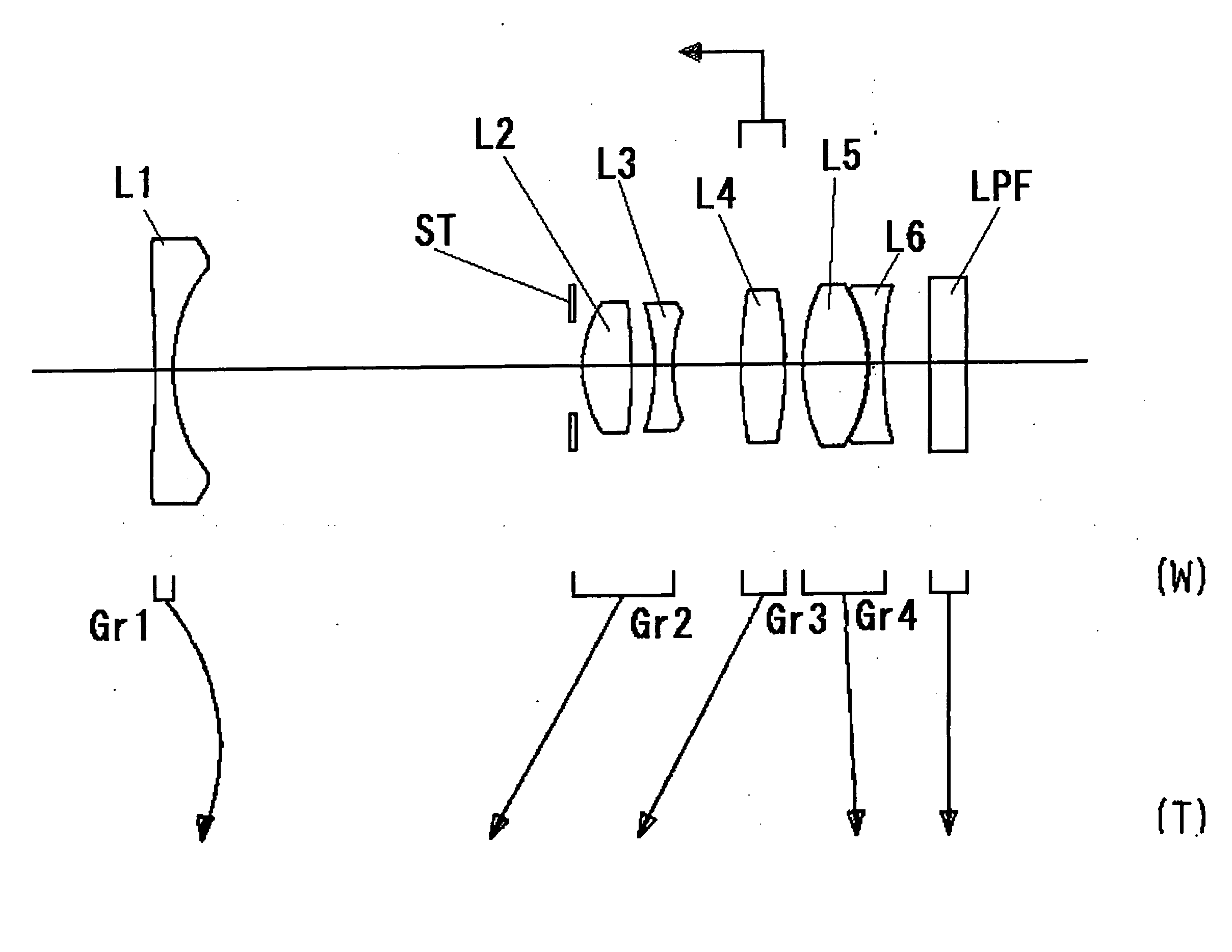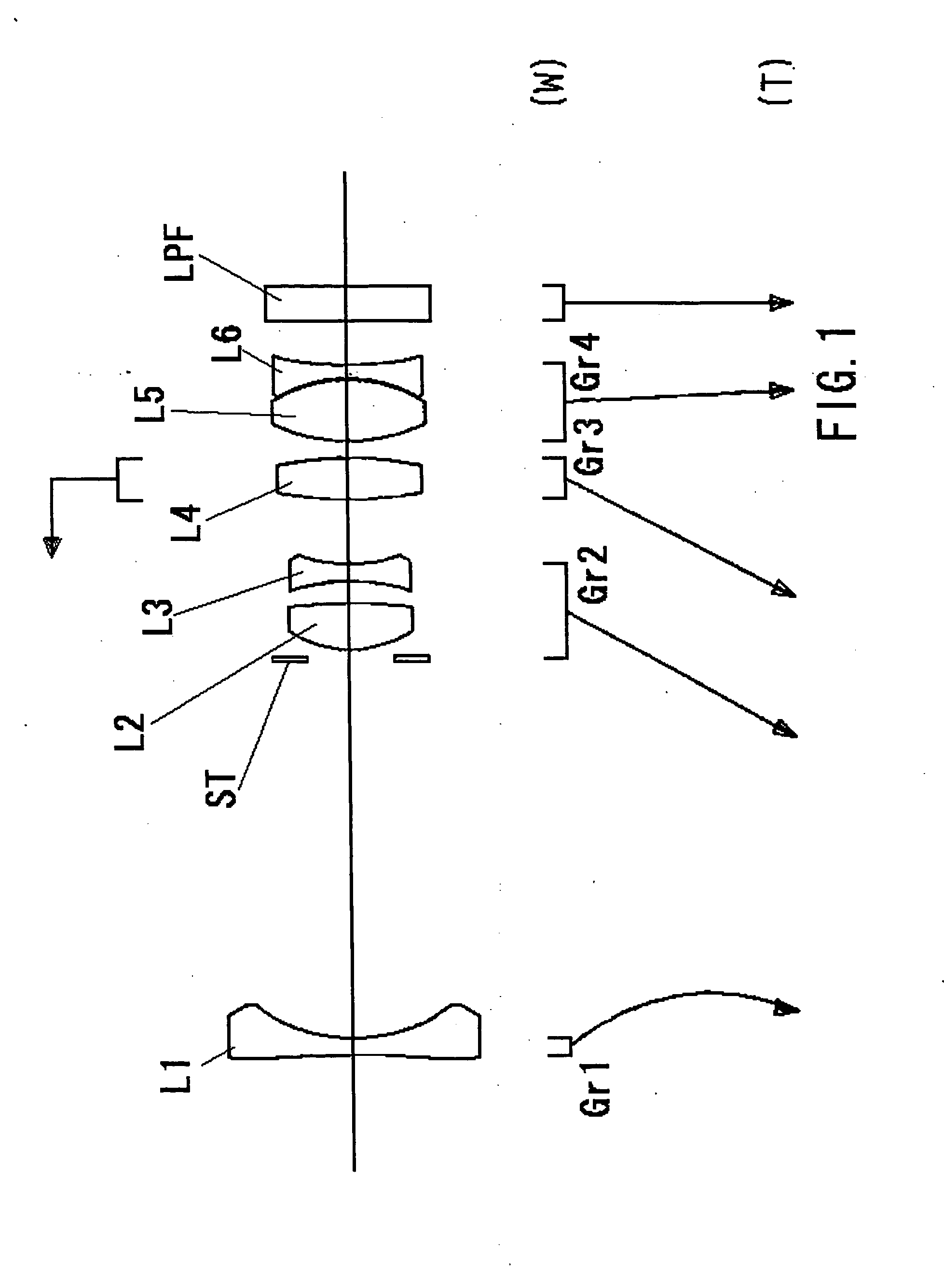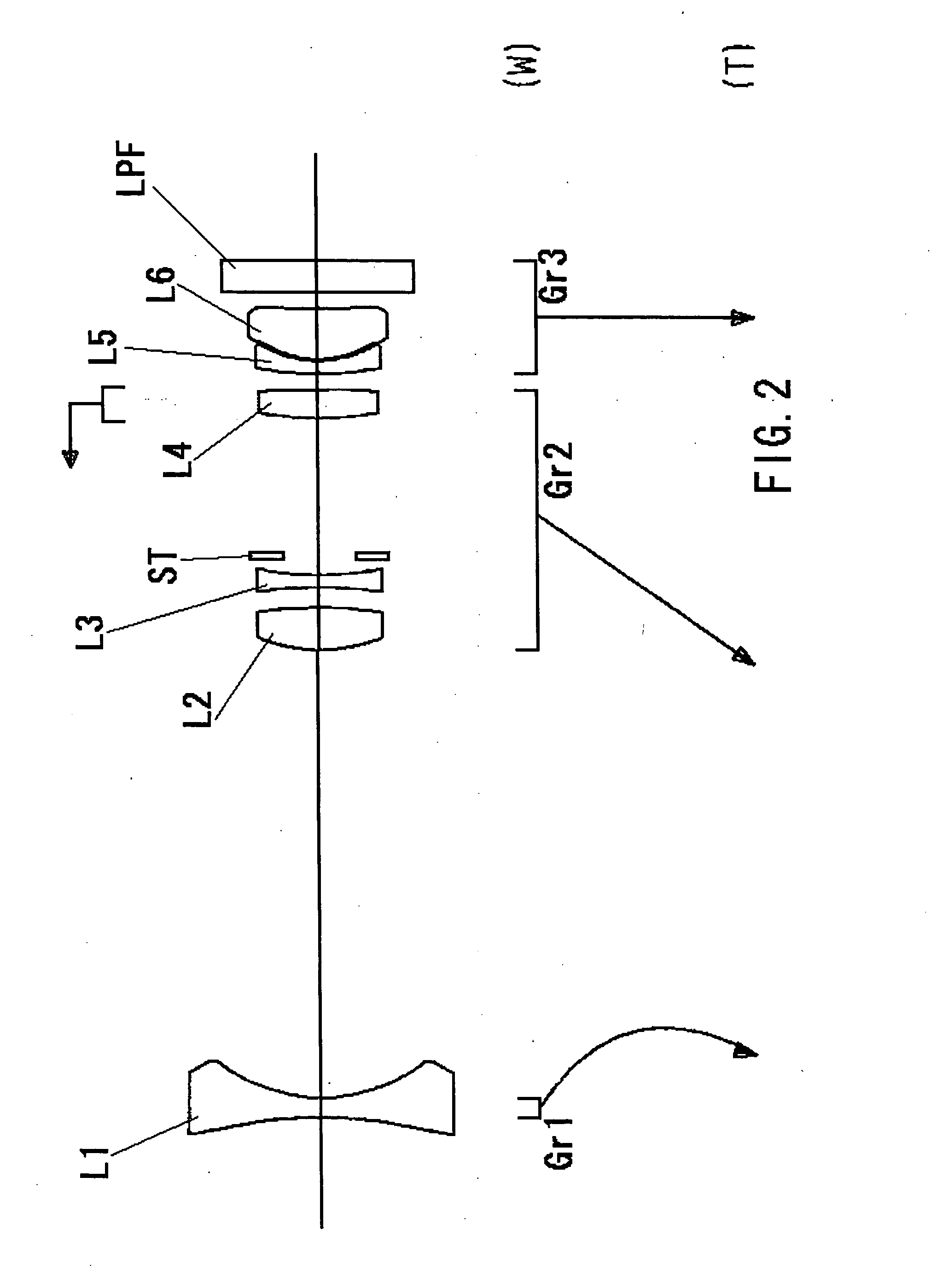Zoom lens system and imaging device having the same
a zoom lens and imaging device technology, applied in the direction of instruments, optical elements, mountings, etc., can solve the problems of insufficient peripheral light security, difficult setting of the microlens pupil, and insufficient optical performance of image sensors
- Summary
- Abstract
- Description
- Claims
- Application Information
AI Technical Summary
Benefits of technology
Problems solved by technology
Method used
Image
Examples
example 1
f = 6.0 − 10.8 − 17.3 mmFNo. = 2.95 − 3.46 − 4.24[Radius of Curvature][Axial Distance][Refractive Index(Nd)][Abbe Number(νd)]r1* = −180.565d1 = 1.000N1 = 1.49310ν1 = 83.58r2* = 8.101d2 = 22.102 −8.977 − 3.301r3 = ∞d3 = 0.600r4 = 6.286d4 = 2.725N2 = 1.74159ν2 = 43.17r5 = −29.861d5 = 1.300r6* = −11.145d6 = 1.000N3 = 1.84666ν3 = 23.82r7* = 10.004d7 = 3.742 −4.916 − 4.596r8 = 21.104d8 = 2.414N4 = 1.80513ν4 = 44.41r9 = −20.523d9 = 1.000 −6.985 − 16.317r10 = 10.089d10 = 3.566N5 = 1.48749ν5 = 70.44r11 = −8.086d11 = 0.100r12 = −7.873d12 = 0.800N6 = 1.58340ν6 = 30.23r13* = 25.439d13 = 2.550 −2.460 − 1.116r14 = ∞d14 = 2.000N7 = 1.51633ν7 = 64.14r15 = ∞[Aspherical Coefficient]r1ε = 0.10000E+01A4 = −0.75826E−03A6 = 0.34105E−04A8 = −0.50991E−06A10 = 0.25871E−08r2ε = 0.10000E+01A4 = −0.10941E−02A6 = 0.26338E−04A8 = 0.51284E−06A10 = −0.16952E−07r6ε = 0.10000E+01A4 = −0.31416E−03A6 = 0.93704E−05A8 = 0.43331E−05A10 = −0.34297E−06r7ε = 0.10000E+01A4 = 0.55006E−03A6 = 0.43702E−04A8 = 0.29782E−05A10 = ...
example 2
f = 5.6 − 16.1 − 21.2 mmFNo. = 2.95 − 4.51 − 5.27[Radius of Curvature][Axial Distance][Refractive Index(Nd)][Abbe Number(νd)]r1* = −39.852d1 = 1.200N1 = 1.49310ν1 = 83.58r2* = 7943d2 = 27.324 −5.086 − 2.210r3 = 9.089d3 = 2.617N2 = 1.75450ν2 = 51.57r4 = −26.827d4 = 1.220r5* = −45.076d5 = 0.800N3 = 1.84666ν3 = 23.82r6* = 18.718d6 = 1.188r7 = ∞d7 = 8.466r8 = 19.274d8 = 1.710N4 = 1.76213ν4 = 50.28r9 = −79.564d9 = 1.000 −13.487 − 19.631r10 = 19.602d10 = 0.800N5 = 1.79850ν5 = 22.60r11 = 6.499d11 = 0.100r12* = 5.624d12 = 3.076N6 = 1.52510ν6 = 56.38r13* = 67.250d13 = 1.000r14 = ∞d14 = 2.000N7 = 1.51680ν7 = 64.20r15 = ∞[Aspherical Coefficient]r1ε = 0.10000E+01A4 = −0.64385E−03A6 = 0.20445E−04A8 = −0.22702E−06A10 = 0.79381E−09r2ε = 0.10000E+01A4 = −0.10137E−02A6 = 0.90231E−05A8 = 0.49260E−06A10 = −0.10596E−07r5ε = 0.10000E+01A4 = −0.61443E−03A6 = 0.40451E−04A8 = −0.38476E−05A10 = 0.18991E−06r6ε = 0.10000E+01A4 = −0.28745E−03A6 = 0.58066E−04A8 = −0.54298E−05A10 = 0.27306E−06r12ε = 0.10000E+01A...
example 3
f = 5.6 − 16.1 − 21.3 mmFNo. = 2.95 − 4.07 − 4.61[Radius of Curvature][Axial Distance][Refractive Index(Nd)][Abbe Number(νd)]r1* = −35.240d1 = 1.200N1 = 1.49310ν1 = 83.58r2* = 8.469d2 = 27.719 −4.808 − 1.846r3 = 8.794d3 = 2.582N2 = 1.74754ν2 = 51.81r4 = −25.730d4 = 0.600r5 = ∞d5 = 0.600r6* = −42.662d6 = 0.800N3 = 1.84666ν3 = 23.82r7* = 17.339d7 = 8.811r8 = 18.677d8 = 2.126N4 = 1.78578ν4 = 46.80r9 = −72.376d9 = 1.000 −12.250 − 17.785r10 = 21.040d10 = 0.800N5 = 1.79850ν5 = 22.60r11 = 6.402d11 = 0.115r12* = 5.787d12 = 3.146N6 = 1.52510ν6 = 56.38r13* = 69.497d13 = 1.000r14 = ∞d14 = 2.000N7 = 1.51680ν7 = 64.20r15 = ∞[Aspherical Coefficient]r1ε = 0.10000E+01A4 = −0.62293E−03A6 = 0.22312E−04A8 = −0.26635E−06A10 = 0.96658E−09r2ε = 0.10000E+01A4 = −0.92271E−03A6 = 0.10117E−04A8 = 0.59055E−06A10 = −0.13036E−07r6ε = 0.10000E+01A4 = −0.68242E−03A6 = 0.42598E−04A8 = −0.36680E−05A10 = 0.18704E−06r7ε = 0.10000E+01A4 = −0.32785E−03A6 = 0.63607E−04A8 = −0.55179E−05A10 = 0.28183E−06r12ε = 0.10000E+01...
PUM
| Property | Measurement | Unit |
|---|---|---|
| optical power | aaaaa | aaaaa |
| focal length | aaaaa | aaaaa |
| Abbe number | aaaaa | aaaaa |
Abstract
Description
Claims
Application Information
 Login to View More
Login to View More - R&D
- Intellectual Property
- Life Sciences
- Materials
- Tech Scout
- Unparalleled Data Quality
- Higher Quality Content
- 60% Fewer Hallucinations
Browse by: Latest US Patents, China's latest patents, Technical Efficacy Thesaurus, Application Domain, Technology Topic, Popular Technical Reports.
© 2025 PatSnap. All rights reserved.Legal|Privacy policy|Modern Slavery Act Transparency Statement|Sitemap|About US| Contact US: help@patsnap.com



